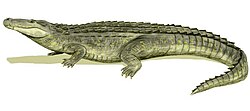| Protocaiman Temporal range: Paleocene, | |
|---|---|
| Scientific classification | |
| Kingdom: | Animalia |
| Phylum: | Chordata |
| Class: | Reptilia |
| Clade: | Archosauria |
| Order: | Crocodilia |
| Family: | Alligatoridae |
| Subfamily: | Caimaninae |
| Genus: | † Protocaiman Bona et al., 2018 |
| Species: | †P. peligrensis |
| Binomial name | |
| †Protocaiman peligrensis Bona et al., 2018 | |
Protocaiman is a caimanine genus of crocodylian first described in 2018. The type species Protocaiman peligrensis was discovered in Argentina's Salamanca Formation, and lived in Patagonia during the Paleocene epoch. [2] The holotype is specimen MLP 80-X-10-1, which is a partial skull. [3]


